| I really should be finishing up some
real work, but the “Coureur des Bayou”
is leaving Carnacks at the moment and I feel compelled
to start this article as the drama is playing out
in the Yukon. The “Boys from the Bayou”
have a slim 14 minute lead over the second place boat
after 325km of hard charge racing. The balance of
the lead boats are clustered around an hour and a
half back, 4 boats within 26 minutes of each other.
As always, it is paddlers that win races, the boat
is but a tool they use in the endeavor. This is about
the design and building of such a tool, a Voyageur
for the Boys from the Bayou.
The Design
When Richard Ameen approached me last year about
designing a Voyageur for the Yukon River Quest, the
only question was, “how many paddlers are you
going to have?” Once the governing body finalized
the rules, we had a choice of 3 sizes within the class.
(A)
28’ LOA, 36” minimum beam at the 6”
waterline
(B) 34’ LOA, 44” minimum beam at the
6” waterline
(C) 42’ LOA, 48” minimum beam at the
6” waterline
In each case the boat had to be a minimum of 18 inches
deep at the gunnels, 6 man minimum, single blade paddles.
Preliminary calculations ran out that the 28’
boat wanted a 6 man crew, the 34’ boat an 8
man crew and the 42’ boat 14 paddlers.
The biggest size was dropped from consideration,
too many people involved, the other two sizes have
virtually identical L/B ratios (9.33 and 9.27) so
the decision was based on the number of premier paddlers
Richard could recruit for the effort. Eight it is.
Based on previous ruminations with Texas Water Safari
boats, the paddlers equivalent to the drag racers
“there’s no substitute for cubic inches”
holds true but there is diminishing returns as you
add paddlers past 5 or 6. Still a 34-foot long boat
should be better/quicker than 28 footer. Particularly
since there are no portages or really twisty narrow
spots in this race.
Weight estimates and fixed dimensions in hand preliminary
design is pretty straightforward. 6” by 44”
midsection times about .8 gives a midsection of 1.47
square feet times a length of 34 feet with a prismatic
coefficient of 0.50 equals 24.93 cubic feet or 1556
fresh water pounds. Dead on, just less than 200#/paddler
which is a little conservative, since these guys don’t
carry any extra weight on their persons.
To squeeze the last little bit of drag out of the
boat a number of Godzilla optimization routines were
run through Mitchlet to fine tune the shape below
the waterline. A graph of relative drag is included
for those interested in the fiddling details [see
below]. The graph compared the drag versus speed for
a single paddler in four different boats. The 2 man
shallow water data was included just because it was
handy and adds a little perspective to the forces
involved. The cyan ‘base’ curve is a non
optimized but generally well shaped 8 man voyageur
(preliminary design) . Yellow curve is the optimized
shape for the same boat. The brown curve for a paddler
in a 6 man safari style boat shows the difference
a little beam makes. Up to about the 24th tick on
the speed scale, (about 6mph) The Voyageur has an
advantage based on relatively smaller wetted surface.
Then the smaller cross section of the Safari boat
makes less waves and will pull away from the voyageurs
if all the paddlers are putting out a constant force
of 0.02 kilonewtons.
 |
I have included
this graph of relative drag for those interested
in the fiddling details - click the image
at left for the PDF file. |
Please take all this with a large grain of salt.
The graph is a reasonable reflection of reality but
doesn’t take into consideration our theoretical
paddlers training, heredity or heart, which will trump
any increase or decrease in area under a graph. Still
its good to give these paddlers the best boat possible.
Once the underwater shape is fixed it is time to
shape the topsides which is primarily adding some
tumblehome to the center of the boat and flaring out
a ‘sterncastle’ in the stern to get the
steersman paddler as far aft as possible. In this
case there is enough depth in the bow to decide that
no extra bumps or flares are needed for extra volume.
In this particular case I did the tumblehome section
three times.
First time I rolled the sections to a parallel line
on the basis that it would be the easiest for George
to cut out all those patterns. George is something
of a perfectionist, and thought the boat would be
better if it didn’t have that ‘hard spot’
where the sections transitioned from natural to rolled.
The sections were redone in that area and stripping
started. Still doesn’t look quite right….
Finally I redo the sections the way they should have
been done in the first place and building commences.
The Build
| George with boat
- Foam is stripped over male form much like a
conventional stripper. |
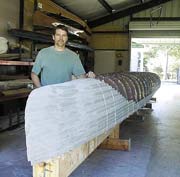
|
Kevlar, carbon fiber and a touch of s-glass each
side of 3/8” (9mm) 5#/cubic foot divinylcell
foam. Foam is stripped over male form much like a
conventional stripper. Outer skin is laid up, carbon
fiber followed by s-glass and smoothed up with a layer
if peel ply. A large crew required for layup operation,
in the picture left to right, Richard Ameen, Wade
Binion, John Hoffart, George Melder, all team members
and Gary Kohut on far side of boat. Present but not
in picture, John Qualls, team member and yours truly
who usually shows up and mixes epoxy at these events.
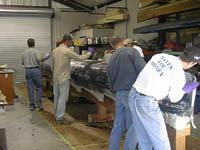 |
Outer skin
is laid up - left to right, Richard Ameen, Wade
Binion, John Hoffart, George Melder, all team
members and Gary Kohut on far side of boat. |
| Once the outer skin
has cured, the boat is taken off the form and
prepped for the inside laminate |

|
Once the outer skin has cured, the boat is taken
off the form and prepped for the inside laminate.
Then the inside laminate is applied, kevlar, and a
blend of carbon/s-glass. If anything, applying the
inside laminate is a little more frenzied process
than applying the outer, witness no one took any good
pictures but I believe there were 8 of us. The interior
laminate is vacuum bagged which entails adding a couple
of lavers of bleeder cloth and absorption material
over laminate and then wrapping the whole boat in
a nylon bag and applying a vacuum (5-7 psi) to consolidate
the laminate and remove any excess resin.
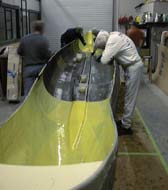 |
Then inside
laminate applied, kevlar, and a blend of carbon/s-glass. |
At this point the hull is done except for some trim
work, gunnel reinforcing and the like. I was of the
opinion that the boat needed to have a couple of bulkheads
in the middle of the boat (like the plans showed)
to stiffen the hull and keep the gunnels from panting
(moving in and out). Turned out that with the seat
braces in place, no matter how hard you pushed and
pulled, the gunnels just stayed in place. Amazing
stiffness with all that carbon fiber.
Rigging
In many respects a voyageur is simpler than a safari
boat, light requirements are minimal, it is after
all going to race in the land of the midnight sun.
Gear requirements are different but there is an enormous
amount of room available, particularly compared to
a safari boat. The big question regarding rigging
was the seating setup. All the crew had read an outstanding
article by one of last years top voyageur finishers
and the description of switching from side to side
on bench seats was a matter of some concern. These
guys hate to miss a single stroke and the thought
of missing several strokes while clambering around
every 50 or so strokes was the stuff of nightmares.
George asked me if I thought that there was room to
have everybody in a line and after a quick check,
the answer was yes, actually there was plenty of room.
Then George had a brilliant idea, make the center
seats slide from side to side, so its quicker and
easier to swap sides, and by the way not miss a stroke….ever.
The lateral sliding seats used in the center 4 positions
were elegantly executed using hardware for an exercise
rowing machine.
| Then George had
a brilliant idea, make the center seats slide
from side to side, so its quicker and easier to
swap sides, and by the way not miss a stroke….ever. |
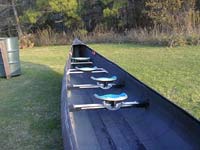
|
Since this was a new innovation, the boys asked me
to hold off writing anything about the boat until
they actually raced it. A reasonable request, actually
they paddle faster than I write and now have won the
2007 Yukon
River Quest in a record time 41hrs 15
min unofficially, one hour one minute ahead of the
second place boat. The lateral sliding seats may have
helped, but they won with teamwork and heart.
Interestingly initial trials brought to light one
aspect of the lateral sliding seats no one had considered
beforehand. If you miss hearing the call to hut (switch),
the boat will heel to your side when there are suddenly
3 people on one side and only one on the other. Then
is a long way uphill to slide to get to the proper
side. Apparently every one learns this quickly and
it is not a problem. Do note though that the one time
this designer was in the boat, I’m in one of
the fixed seats [TRIAL TWO].
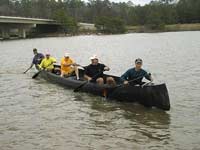 |
If you miss
hearing the call to hut (switch), the boat will
heel to your side when there are suddenly 3
people on one side and only one on the other... |
| Apparently every
one learns this quickly and it is not a problem.
Do note though that the one time this designer
was in the boat, I’m in one of the fixed
seats - second from the front. |
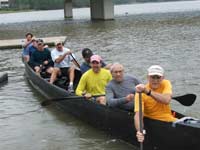
|
Last Practice
Susie had allowed that she hadn’t seen the
new boat and would like to see it in the water before
it left for points north. We went up to Lake Conroe
and watched the last practice, which included all
the Texas team members plus a couple of good local
paddlers to fill in for the two team members from
the Northwest
Pictures and captions
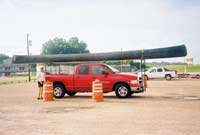 |
That’s
a full size pickup |
| Half the crew can
easily move the boat |

|
 |
Wade, John,
Pete, John, Grady, Richard, John and George |
| About 3 boat lengths
and they are up to speed; probably exceeding the
marina speed limit but not leaving a wake. |
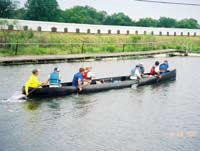
|
 |
Note that everyone
except Grady has changed position and was surely
done without slowing down. |
| Off to the Yukon |
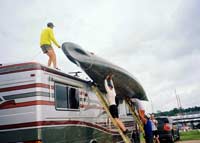
|
Postscript
A new voyageur record, the first time a voyageur
had won first place, beating two local favorites that
expected to win the race, heady accomplishments for
a team that hadn’t been there before.
Kudos to:
Richard Ameen, who put it all together
George Melder, builder extraordinary
The two Johns, Qualls and Hoffart
Pete and Wade Binion, father and son
(Pete did a paddlers trifecta this year, 1st masters-Ruta
Maya, 1ST TWS, 1st YRQ)
Edoh Amiran, navigator extraordinary
Liam Price, steersman
I’m honored to have helped in a small way.

Other articles by Skip Johnson:

|